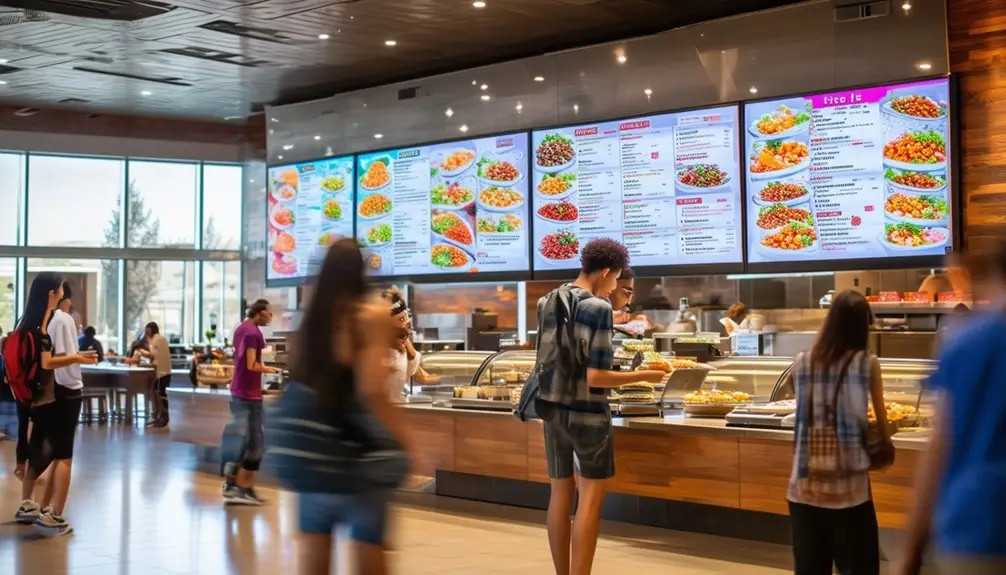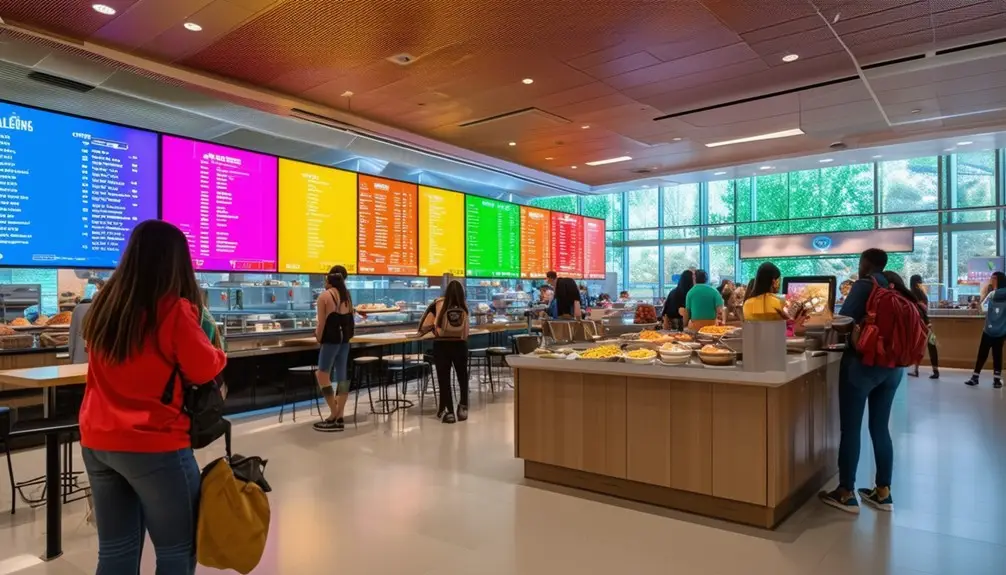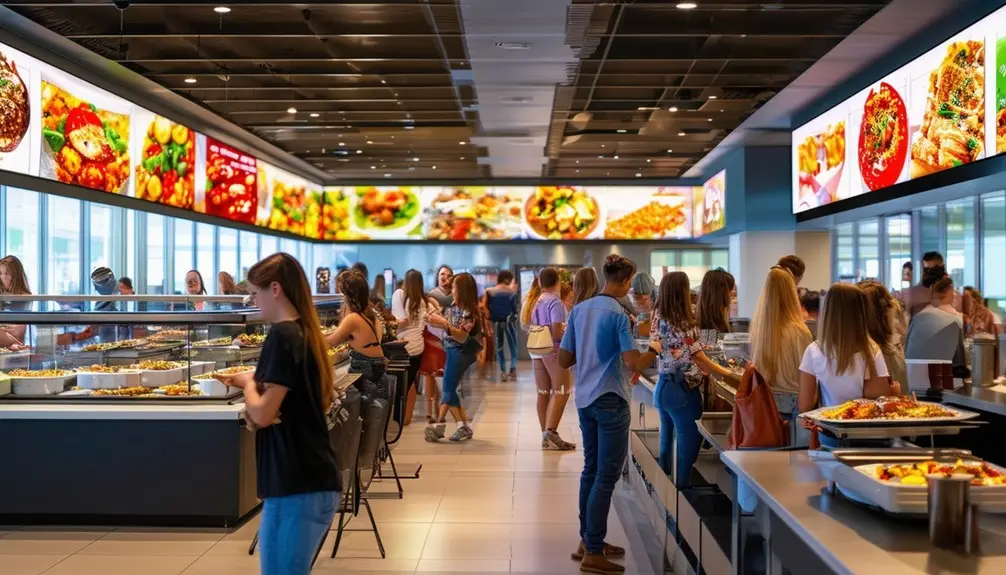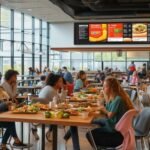You’ll improve your college dining experience with dynamic digital menus by boosting in-store traffic up to 33% and influencing 68% of customers to buy. They streamline menu updates, reducing printing costs by 60% and staff hours by 50%. Remote management allows real-time changes and maintains consistency. Integrate social media to increase engagement by 40% and improve brand awareness. Customizable menu boards ensure you can easily update specials and prices in real-time. Leveraging customer analytics, you’ll gain insights into student preferences, optimizing offerings and promotions. Explore how these features drive a more engaging and efficient dining experience.
Key Takeaways
- Increase sales and enhance the dining experience with visually engaging and interactive digital menus.
- Make real-time menu changes based on inventory and customer preferences from a centralized location.
- Reduce printing expenses by up to 60% and save on staff hours for manual updates.
- Integrate live social media feeds to boost customer engagement and increase repeat visits.
- Utilize customer analytics to create personalized menu recommendations and develop targeted marketing strategies.
Benefits of Digital Menus

Implementing digital menus in college dining facilities can boost in-store traffic by up to 33% and influence 68% of customers to make a purchase. Adopting a dynamic digital menu can notably increase sales and enhance the overall dining experience. These digital platforms allow for quick updates, enabling you to showcase seasonal specials and promotions effectively. Unlike static traditional menus, dynamic digital menus offer a visually engaging and interactive experience that can captivate students and staff alike.
Incorporating digital menus helps you establish a unique brand identity, setting your dining facility apart from competitors. With nearly 50% more brand awareness compared to traditional menus, digital solutions provide a competitive edge. Customizable and on-brand digital menus foster better customer engagement, translating directly into higher sales revenue.
The ability to update menu items swiftly ensures that your offerings remain relevant and appealing. This flexibility not only keeps your customers engaged but also encourages repeat visits. By leveraging the power of digital menus, you can create a dynamic dining environment that not only attracts more foot traffic but also drives sustained revenue growth for your college dining facility.
Cost-Saving Solutions
You’ll find digital menu boards greatly reduce costs, saving up to 25% on printing expenses annually. They also streamline operations, cutting staff hours spent on manual updates by up to 50%. These efficiencies not only save money but also enable quicker response to inventory changes, maximizing cost-effectiveness.
Reduce Printing Costs
Shifting to dynamic digital menus can reduce printing expenses by up to 60%, freeing up funds to enhance the overall dining experience for students. This substantial cost decrease arises from the elimination of frequent menu updates and reprints, making it a wise choice for college dining facilities. By investing in a digital signage solution, you can save money that was previously utilized for traditional printing methods.
Introducing dynamic digital menus not only cuts printing costs but also offers a cost-efficient solution for streamlining operations. Conventional menus necessitate constant updates and reprints, which can swiftly accumulate both in terms of time and financial resources. With digital menus, these recurring expenses are practically eliminated, allowing you to allocate those savings toward improving other aspects of the dining experience.
The funds saved from reduced printing expenses can be reinvested in various areas of campus dining services, such as enhancing food quality, expanding menu options, or upgrading dining facilities. By adopting digital menus, colleges can guarantee that their budget is utilized more effectively, ultimately enhancing student satisfaction and creating a more vibrant dining environment. This strategic change not only optimizes financial resources but also enriches the overall dining experience for students.
Efficient Menu Updates
Utilizing dynamic digital menus enables college dining facilities to efficiently update menu offerings, ultimately saving up to 30% in printing costs and reducing manual labor to a large extent. With digital menu boards, you can introduce new menu items quickly, leading to a 20% increase in student engagement and satisfaction. These boards offer an intuitive interface that allows for real-time updates, ensuring that your menu is always current without the need for time-consuming manual changes.
Efficient menu updates through dynamic digital systems also allow you to respond promptly to inventory levels, thereby reducing food waste by up to 15%. This capability is particularly beneficial during peak seasons when menu item popularity can vary significantly. By implementing digital menus, you can easily swap out less popular items for those in higher demand, contributing to a 25% increase in menu item popularity.
The time savings are substantial. Staff can cut the hours spent on manual updates by up to 50%, freeing them up for other essential tasks. This increased efficiency not only enhances operational workflows but also contributes to a more sustainable and cost-effective dining solution.
Remote Management

With remote management, you can control digital menu content from a centralized location, ensuring consistent updates across all campus dining facilities. This system allows you to make real-time menu changes based on inventory and customer preferences, enhancing operational efficiency. You can tailor your offerings by leveraging data-driven insights to boost engagement and sales.
Centralized Content Control
Centralized content control empowers college dining facilities to remotely manage their digital menus, streamlining updates and maintaining uniformity across campus dining locations. By leveraging this dynamic feature, you can effortlessly adjust menu items, promotions, and nutritional information from a central hub. This not only saves time but also reduces the likelihood of errors that come with manual updates.
Imagine introducing new items or adjusting prices across all dining halls without leaving your office. Centralized content control makes this possible, allowing you to maintain consistency and quality in your offerings. Whether you’re promoting a special dish or updating dietary information, remote management guarantees that every digital menu reflects the latest data.
Data-driven insights can guide you in scheduling content to match peak dining times, enhancing the overall student experience. Additionally, the ability to quickly adapt to student preferences and dietary needs fosters a more responsive and engaging dining environment. By embracing centralized content control for your digital menus, you not only streamline operations but also elevate the dining experience, making it more dynamic and user-focused.
Real-Time Menu Updates
Leveraging centralized content control, college dining facilities can now implement real-time menu updates through remote management, ensuring that every menu item, price, and promotion is current and accurate. This feature allows you to introduce new dishes quickly, adjust prices based on inventory levels, and showcase seasonal specials without any manual intervention.
Utilizing remote management for digital menus not only saves valuable staff hours but also reduces the costs associated with traditional printed menus. With real-time menu updates, students and staff always have access to the latest dining options, significantly enhancing their overall dining experience. This seamless integration improves operational efficiency and can drive higher sales revenue.
Here’s a quick glance at the benefits:
| Benefit | Description | Impact |
|---|---|---|
| Time Savings | Eliminates manual updates | Frees up staff for other tasks |
| Cost Efficiency | Reduces print costs | Lowers operational expenses |
| Enhanced Dining Experience | Provides current and accurate menu information | Improves customer satisfaction |
Social Media Integration

Incorporating social media into dynamic digital menus can greatly enhance customer engagement, driving up to a 40% increase. Leveraging social media integration not only boosts customer engagement but also markedly raises brand awareness. Platforms like Instagram and Facebook, when showcased on digital menus, encourage students to interact with your dining services, leading to a more connected and vibrant dining environment.
By including live social media feeds, you can display customer-generated content, which enhances brand visibility and fosters customer loyalty. This integration results in a 25% increase in online orders, as students are more likely to try and share trending menu items they see on social media.
This approach can lead to a 30% rise in customer satisfaction and repeat visits. Students appreciate seeing familiar faces and real-time updates, which make their dining experience more personalized and engaging. Encouraging user-generated content sharing not only enriches the dining experience but also serves as free marketing. This continuous loop of engagement and sharing markedly ensures your dining services stay top-of-mind for students, driving both immediate and long-term benefits. Integrating social media into your digital menus is a strategic move that pays off in multiple dimensions.
Customizable Menu Boards

Customizable menu boards in college dining offer a dynamic and flexible solution for updating daily specials, promotions, and prices in real-time. You can effortlessly showcase various menu items, ensuring that students and staff always have access to the latest offerings. By incorporating attractive digital displays, these boards not only catch the eye but also enhance the overall dining experience.
With customizable menu boards, you can easily modify content to display promotions tailored to specific events or time periods. This flexibility allows you to maintain brand consistency while keeping the visual appeal engaging and relevant. The real-time update capability guarantees that any changes in menu items or prices are promptly reflected, thereby reducing confusion and enhancing customer satisfaction.
Interactive features on these digital boards can greatly boost customer engagement. By encouraging students to explore menu options, you create opportunities for upselling higher-margin items. Additionally, adopting customizable menu boards helps streamline operations. You’ll eliminate the need for printed menus, cutting down on printing costs and reducing waste. This modern dining solution not only meets the evolving needs of a tech-savvy student population but also supports sustainable practices on campus.
Leveraging Customer Analytics

By harnessing the power of customer analytics, college dining services can gain critical insights into student preferences and behaviors, ultimately enhancing the dining experience. Analyzing this data allows you to understand what students like, when they prefer to dine, and how they respond to various menu options and promotions. This invaluable information facilitates the creation of personalized menu recommendations that cater to individual tastes, improving satisfaction and engagement.
With customer analytics, you can develop targeted marketing strategies that resonate with specific student demographics. For instance, if data shows a high demand for vegetarian options among certain student groups, you can promote these offerings more effectively. This targeted approach not only boosts student engagement but also increases sales by meeting specific demands.
Customer analytics enables you to track dining trends and measure the success of menu changes, ensuring that your offerings remain relevant and appealing. By continuously analyzing this data, you can make informed, data-driven decisions to optimize menu offerings, pricing, and promotions. The result? Higher student satisfaction, increased sales, and a superior overall dining experience on campus. Leveraging customer analytics is essential for the continuous improvement and success of college dining services.
Conclusion
Incorporating dynamic digital menus in college dining transforms the experience, making it as invigorating as a cool breeze on a hot day. You’ll save costs, manage menus remotely, and seamlessly integrate social media. Customizable boards cater to diverse tastes, while customer analytics offer a treasure trove of data to refine offerings. Embrace this digital evolution, and watch your dining services flourish like never before. The future of college dining is now in your hands.
Frequently Asked Questions
How Much Do Digital Menu Boards Cost for Restaurants?
Digital menu boards for restaurants cost between $500 and $2,000 per screen. You’ll also need to budget for content creation, software licensing, and maintenance. Customization and interactive features can raise costs, but long-term savings are significant.
What Is a Dynamic Menu Board?
A dynamic menu board is a digital display showcasing real-time food options. It allows instant updates, promotions, and menu changes, increasing sales by up to 38% and enhancing customer engagement with interactive features and eye-catching visuals.
What Is the Difference Between a Digital Menu and a Traditional Menu?
A digital menu lets you update content instantly, offers interactive features, and vibrant visuals. In contrast, a traditional menu is static, requiring frequent reprints, making it less cost-effective and eco-friendly compared to digital options.





